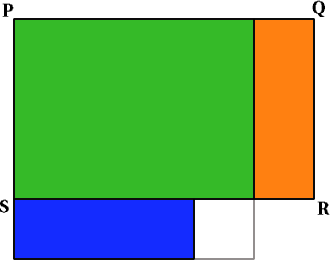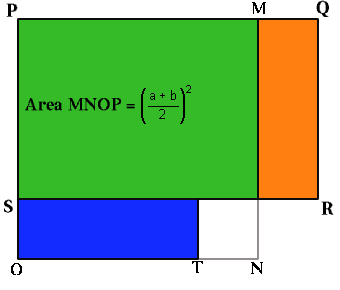AMGM
Can you use the diagram to prove the AM-GM inequality?
Problem

Choose any two numbers. Call them $a$ and $b$ ($b < a$). Work out the arithmetic mean $(a + b)/2$ and the geometric mean $\sqrt{ab}$. Which is bigger? Repeat for other pairs of numbers. What do you notice?
In the diagram PQRS is a rectangle measuring $a$ units by $b$ units. The green rectangle measures $(a + b)/2$ by $b$ and the orange and blue rectangles both measure $(a - b)/2$ by $b$. By considering the areas of the rectangles explain why this diagram shows that $$ab < ({{a + b}\over 2})^2. $$ What does this tell us about the arithmetic mean and the geometric mean of two numbers?
Student Solutions

If we choose any two numbers, call them $a$ and $b$ $(b < a)$ and work out the arithmetic mean $ (a+b)/2 $ and the geometric mean $ \sqrt(ab) $ then the arithmetic mean is always bigger than the geometric mean. How can we prove it? One way is to use this diagram. Clement Goh, age 12 years, from River Valley High, Singapore sent a good solution.
In the diagram the measurements are:
PQ = a
PS = b
PM = PO = (a + b)/2
MQ = SO = TN = (a - b)/2
The blue rectangle measures (a - b)/2 by b , the same as the orange rectangle.
Rectangle PQRS, with area ab, is made up of the green plus the orange rectangle..
The square MNOP, with area [ (a + b)/2 ] 2 , is made up of the green plus the blue rectangles plus the yellow square.
area of MNOP - area PQRS = the area of the yellow square = [ (a - b)/2 ] 2 .
Hence the area of PQRS < area MNOP, that is ab < [ (a + b)/2 ] 2 .
Taking square roots this shows that the geometric mean $ \sqrt(ab) $ is less than the arithmetic mean $ [(a + b)/2] $.
